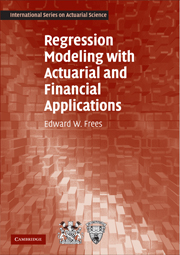Book contents
- Frontmatter
- Contents
- Preface
- 1 Regression and the Normal Distribution
- Part I Linear Regression
- Part II Topics in Time Series
- Part III Topics in Nonlinear Regression
- Part IV Actuarial Applications
- 16 Frequency-Severity Models
- 17 Fat-Tailed Regression Models
- 18 Credibility and Bonus-Malus
- 19 Claims Triangles
- 20 Report Writing: Communicating Data Analysis Results
- 21 Designing Effective Graphs
- Brief Answers to Selected Exercises
- Appendix 1 Basic Statistical Inference
- Appendix 2 Matrix Algebra
- Appendix 3 Probability Tables
- Index
17 - Fat-Tailed Regression Models
Published online by Cambridge University Press: 05 June 2012
- Frontmatter
- Contents
- Preface
- 1 Regression and the Normal Distribution
- Part I Linear Regression
- Part II Topics in Time Series
- Part III Topics in Nonlinear Regression
- Part IV Actuarial Applications
- 16 Frequency-Severity Models
- 17 Fat-Tailed Regression Models
- 18 Credibility and Bonus-Malus
- 19 Claims Triangles
- 20 Report Writing: Communicating Data Analysis Results
- 21 Designing Effective Graphs
- Brief Answers to Selected Exercises
- Appendix 1 Basic Statistical Inference
- Appendix 2 Matrix Algebra
- Appendix 3 Probability Tables
- Index
Summary
Chapter Preview. When modeling financial quantities, we are just as interested in the extreme values as in the center of the distribution; extreme values can represent the most unusual claims, profits, or sales. Actuaries often encounter situations where the data exhibit fat tails, or cases in which extreme values in the data are more likely to occur than in normally distributed data. Traditional regression focuses on the center of the distribution and downplays extreme values. In contrast, the focus of this chapter is on the entire distribution. This chapter surveys four techniques for regression analysis of fat-tailed data: transformation, generalized linear models, more general distributions, and quantile regression.
Introduction
Actuaries often encounter situations in which the data exhibit fat tails, meaning that extreme values in the data are more likely to occur than in normally distributed data. These distributions can be described as “fat,” “heavy,” “thick” or “long” as compared to the normal distribution. (Section 17.3.1 will be more precise on what constitutes fat tailed.) In finance, for example, the asset pricing theories assume normally distributed asset returns. Empirical distributions of the returns of financial assets, however, suggest fat-tailed distributions rather than normal distributions, as assumed in the pricing theories (see, e.g., Rachev, Menn, and Fabozzi, 2005). In health care, fat-tailed data are also common. For example, outcomes of interest such as the number of inpatient days or inpatient expenditures are typically right skewed and heavy tailed as a result of a few high-cost patients (Basu, Manning, and Mullahy, 2004).
- Type
- Chapter
- Information
- Regression Modeling with Actuarial and Financial Applications , pp. 433 - 451Publisher: Cambridge University PressPrint publication year: 2009

